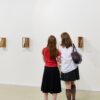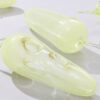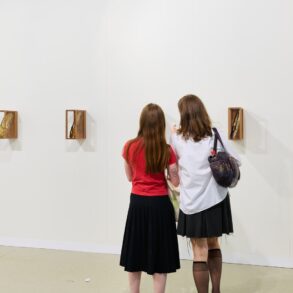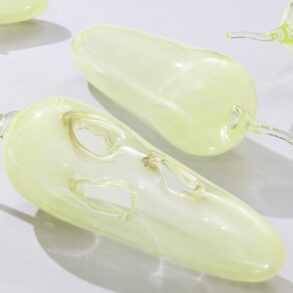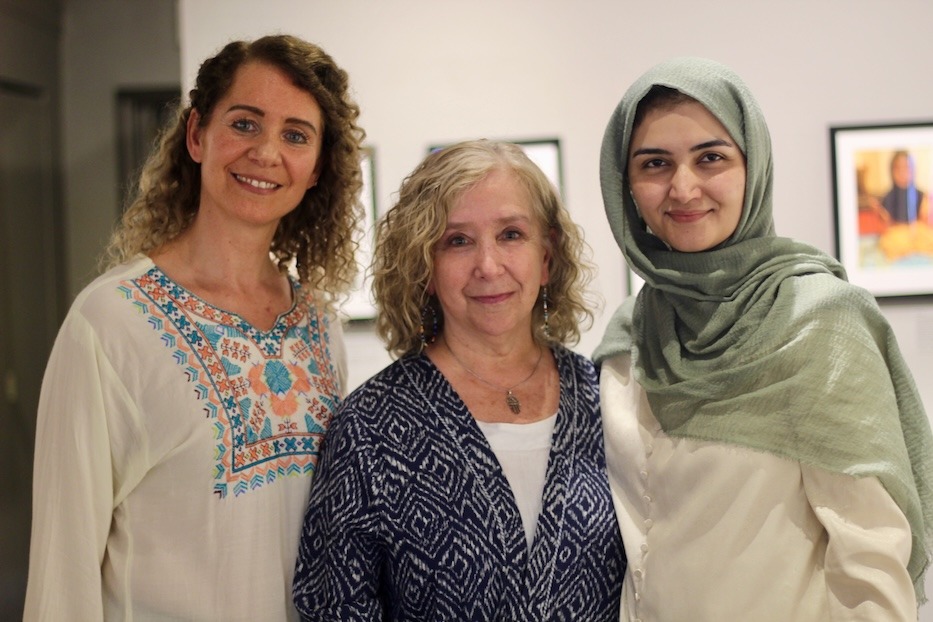
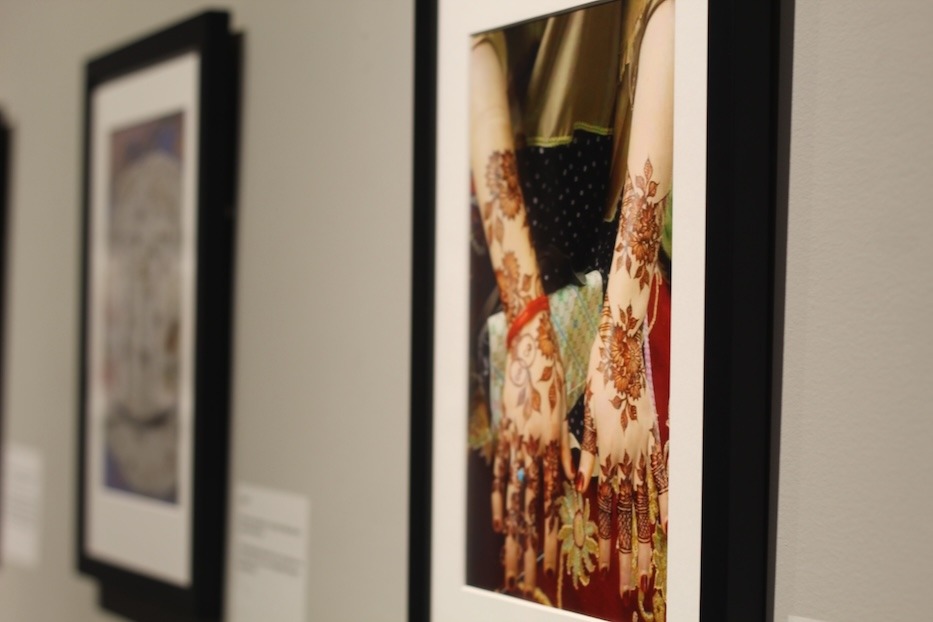
CRIW members Rachele Pierro, Hossna Smadi, and Donna Golden. “Since these women are preliterate, they cannot write or read. This was a good way of expressing to the community what they wanted to say,” Samadi said.
A pair of hands fills the frame, fingers outstretched as the arms reach out toward the viewer. Intricate henna designs bloom across the skin: flowers and climbing vines, with delicate hatching on the fingers. In the background, the folds of a silk dress catch in the light. A dot of turquoise on the right ring finger peeks out, as if it is saying hello.
It is one of several images in “Exploring Themes of Identity & Home,” running now through June 23 at Kehler Liddell Gallery. An initiative of the Collective for Refugee and Immigrant Women’s Wellbeing (CRIW), the show presents photographs by preliterate Afghan women, all of them refugees now living in New Haven.
A tour and gallery talk with CRIW co-founder Hossna Samadi is scheduled for 3 p.m. on Friday, June 21 as part of the International Festival of Arts & Ideas. Registration and more information is available here.
“This is very special and unique,” said Samadi, a translator and vocal advocate for women’s rights who came to New Haven as an Afghan refugee in 2016. “Since these women are preliterate, they cannot write or read. This was a good way of expressing to the community what they wanted to say.”
The show has been almost four years in the making. In late 2020, CRIW grew out of a series of conversations that Samadi, along with refugee advocates Donna Golden and Rachele Pierro, held with each other online. At the time, the Covid-19 pandemic was going on a full year, and all three of them recognized the social, emotional, and financial toll it was taking on the city’s growing refugee community.
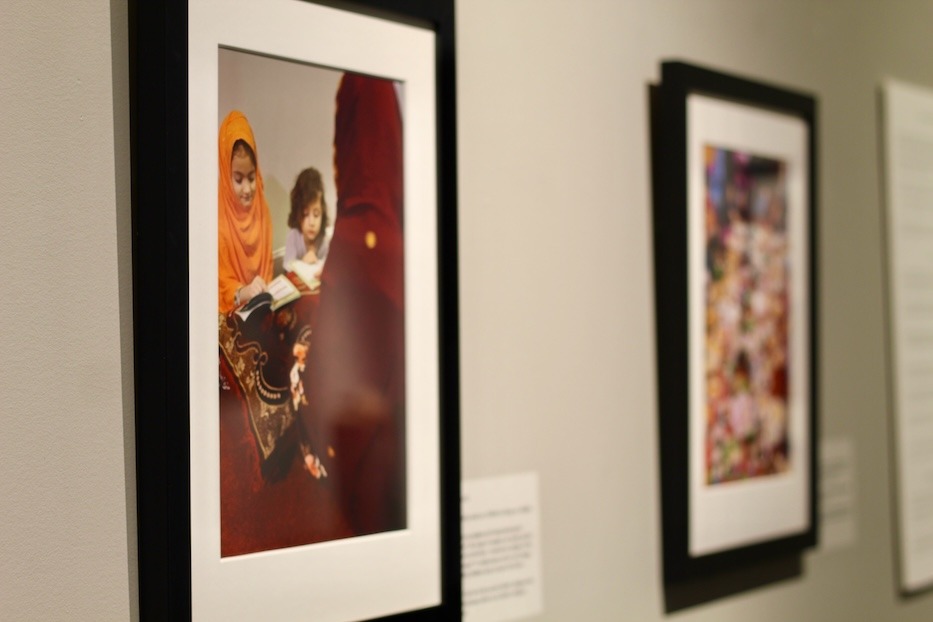
In particular, they focused on a group of preliterate Afghan women, most of them mothers to four or five young children. Even before the pandemic, these women had faced challenges including social isolation, language barriers, and the trauma of forced migration and separation from their families. Most could and did not work outside their homes. Their extended families were often still in Afghanistan. And then the world shut down around them.
“We talked about, how can we help this community?” Samadi recalled. All three have a personal connection to the work: Samadi came to the U.S. as a refugee, Golden is the granddaughter of Jewish refugees who fled the Holocaust, and Pierro worked for years in international relations and human rights before coming to the U.S. from Italy. Without a visa to do that work, she started advocating in different ways.
Both she and Golden have also served as cultural companions with Integrated Refugee and Immigrant Services; Golden is also a co-founder of Sanctuary Kitchen.
After Kabul fell to the Taliban in August 2021, Samadi began hosting a women’s leadership group at the Wilson Branch of the New Haven Free Public Library, close to where many of New Haven’s Afghan families now live. At each meeting, she invited representatives of social service organizations, from the New Haven Board of Education to New Haven Legal Assistance Association to the Liveable City Initiative.
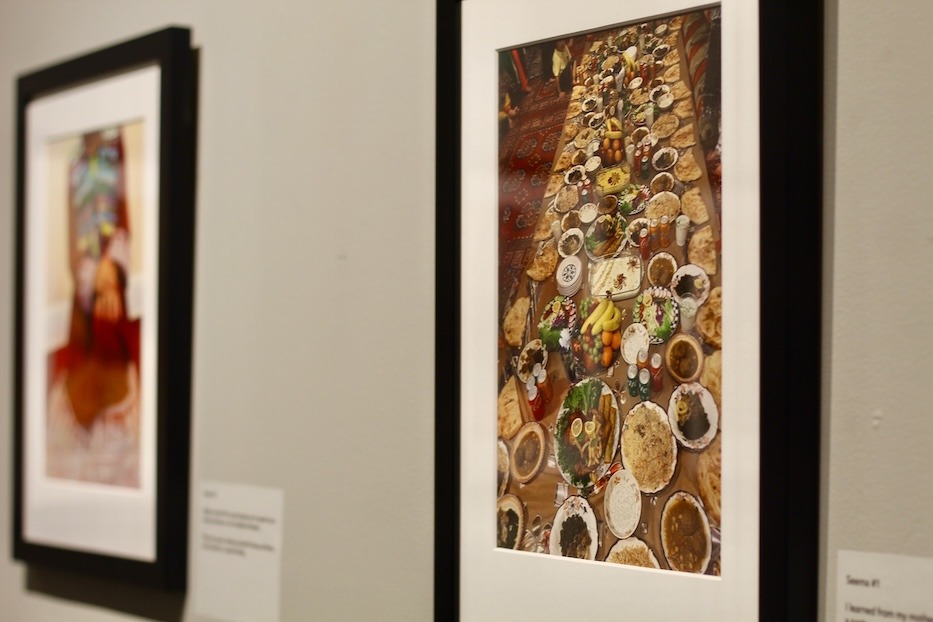
For many of the women, it marked the first time anyone had taught them about tenant’s rights, or explained nuances in the city’s hard-to-navigate public school system. But it was more than that: as they met, the women also built community with each other and with the founders of CRIW. They were able to talk about shared experiences—not only their trauma, but the ways they were practicing religion, raising their children, observing holidays and feeding their families in a totally new place.
The exhibition, which features the work of 10 Afghan women (all exhibit under pseudonyms, to maintain anonymity), grew out of that connection. After what Golden called “a huge amount of trust building,” 10 participants met at Wilson for weekly workshops, including a tutorial from Odette Chavez-Mayo that informed how and what to photograph with the cameras they had on their cell phones.
Using photovoice—a form of participatory photography in which images, group discussion and oral histories drive storytelling—they settled on a theme of “being an Afghan woman.” At home, they documented their lives, from religion and ritual customs to food, their children, and how they created a sense of home almost 7,000 miles away from Afghanistan. Through a translator, they also shared anecdotes about each image, which now accompany the photographs in the exhibition.
“The traditional customs are very important to us,” Samadi said. “What you see on the news—we’re more than that. It’s not just wearing burqa. This is such a beautiful culture.”
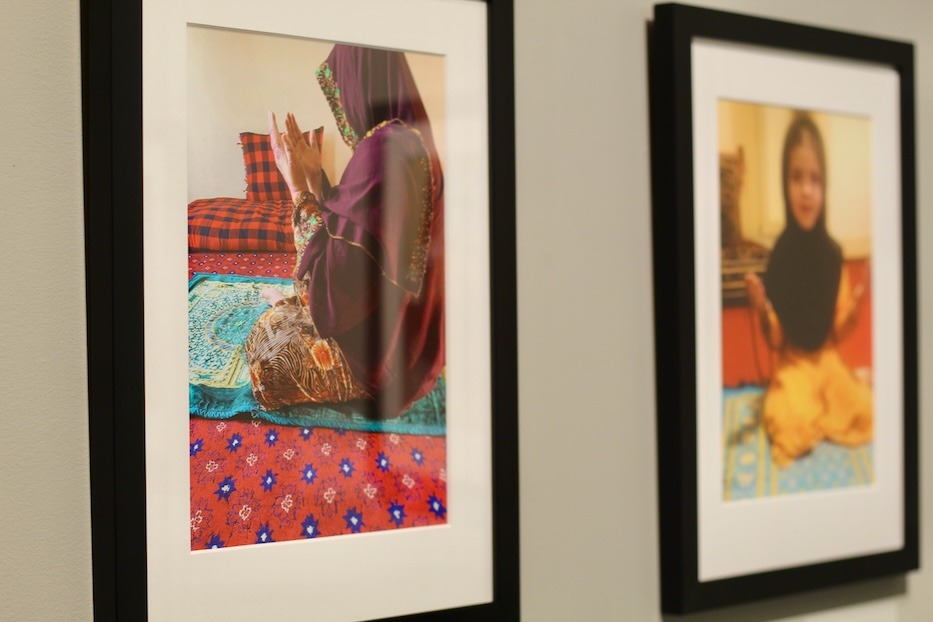 The result is at turns intimate, eye-opening, educational and deeply human. In one image, “Aryana” has photographed her sister-in-law in the midst of prayer, her palms open in front of her face as she bows her head forward.
The result is at turns intimate, eye-opening, educational and deeply human. In one image, “Aryana” has photographed her sister-in-law in the midst of prayer, her palms open in front of her face as she bows her head forward.
An ornate scarf, green and gold at the hem, envelops her head and shoulders. Beneath a floor-length dress, a sliver of foot is visible. A woven prayer rug unfurls beneath her, with butter-colored yellow woven into the teal fabric. On the floor, a second red-and-blue rug covers the space.
For a person who is religious— and perhaps for one who is not— this gesture is so instantly recognizable that a viewer can feel it in their bones. The raised hands are hands that worship, that trust God, that make space for ritual in the dizzying din of daily (and often, very secularized) life in the U.S. They are the hands that rise to put trust in a higher power, in spite of a world turned on its head.
Viewers may know that this is holy, in other words, before anyone tells them it’s holy. But the photographer adds vital context, filling in cultural information that makes the image both her own and part of a teaching moment. For each label, women spoke to a translator, who then wrote their interviews down. Because many of the artists still fear retaliation from the Taliban, nothing was recorded.
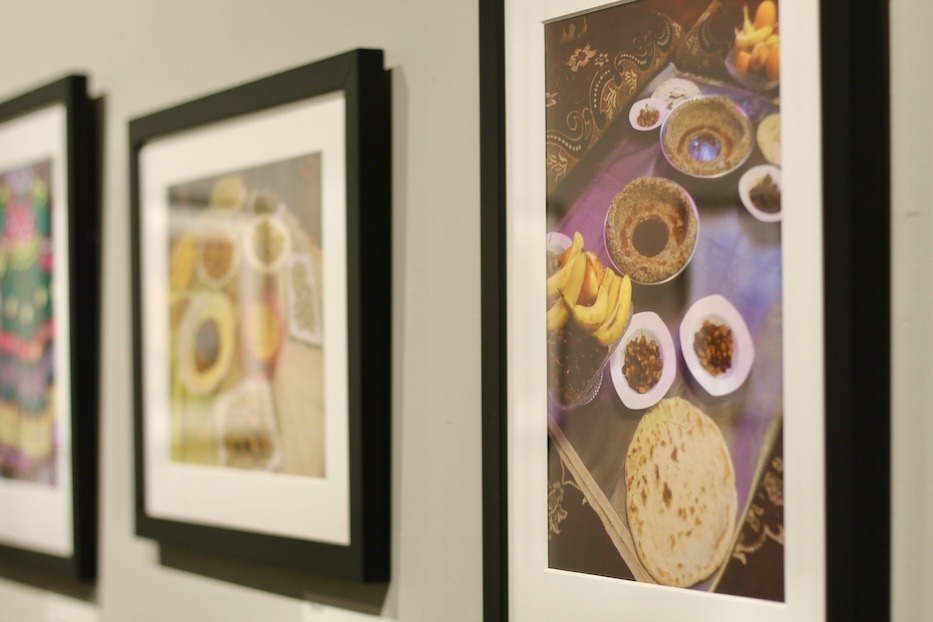
“Afghan women love their religion and trust God,” an accompanying text reads. “This is my sister-in-law making du’a after praying. We can’t pray on the carpet as it can be unclean, so we pray on a special prayer mat. This is very important. In our religion, we pray five times a day. This makes me happy and proud of my religion.”
In a pair of images nearby, “Zaineb” has depicted a tray of food with fruit, nuts, fresh naan and spreads she has prepared for her husband and his friends—a reminder of her silent labor, and keeping a home afloat. In an accompanying text, she explains that cooking for others is a sign of respect and Afghan culture, where even a brief visitor may be received with a vibrant spread.
But, she adds, that doesn’t mean it’s not also exhausting— particularly when paired with raising five young children.
“It’s important for Afghan women to cook well,” the label states matter-of-factly. “It’s a sign of respect to cook for other people, friends and visitors. Here, I had cooked for my husband’s friends who came to visit. While it makes me happy to do this, I remember how tiring cooking can be.”
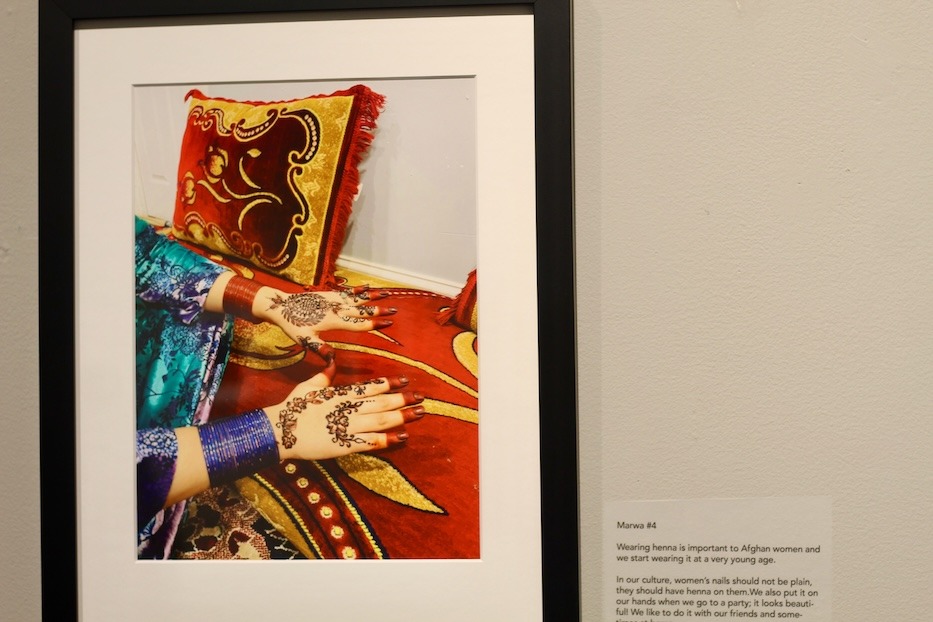
In the same way that food is a cultural connector—anyone who has ever learned to cook as a gesture of love will feel a sense of kinship with these women—several of the photographers have also documented religious rituals and rites of passage that are significant to them.
In a photograph from artist “Marwa,” an ornate bassinet sits beside a couch, decorated with bolts of sky blue silk and white embroidery for her friend’s marizi, or the celebration of the birth of her son. Across the room, another from artist “Zalah” shows the importance of decorating one’s home just as it was in Afghanistan, to create a sense of cultural continuity for the entire family.
“Afghan women want and need to decorate our homes in this way,” reads an accompanying label. “It is very beautiful and it gives me a feeling of home.”
This sense of home as a psychological space is most powerful, perhaps, in images that document the use of traditional henna as a form of ritual and celebration. As several labels explain, the practice of henna in Afghanistan is a celebratory one—and not limited to the intricate, red-brown designs and thick henna paste that one might envision.
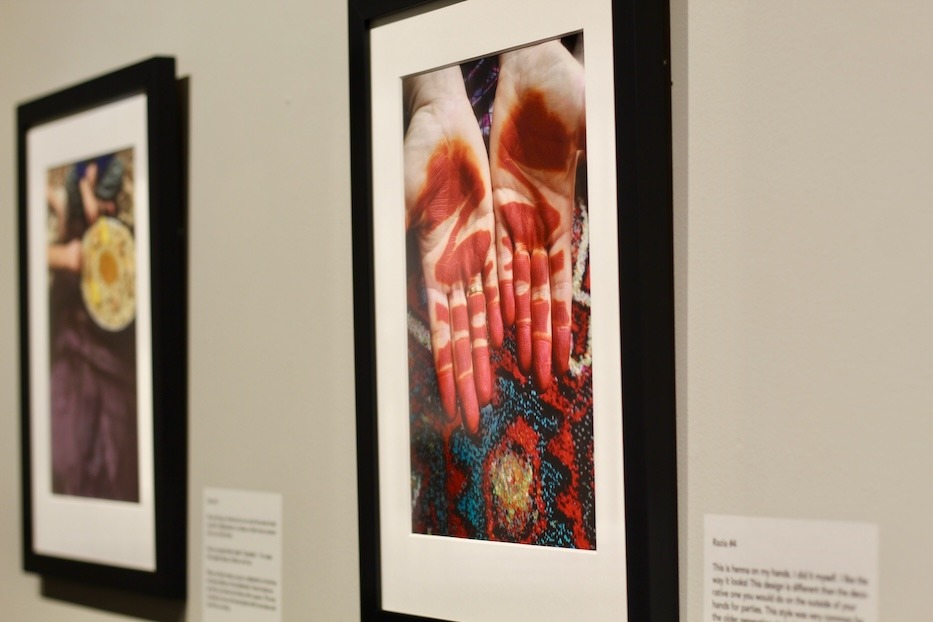
Instead, it takes on many forms, including thick, unbroken circles of red “common to the older generation,” according to a label from Razia. As she explains in a label, the wearer mixes up a mixture firmer than henna paste, rolls it into a ball, and sleeps with it inside their fist. Beside an image illustrating the final product, a photographer has shown her young son in the process of getting henna—because he wanted to be like his mom.
“In the morning, your hands are decorated like this!” the label explains.
While many of the images are joyful, some hold onto the very real grief and complex trauma that comes from leaving one’s home abruptly and as a means of survival. In one of multiple photographs that she has in the show, artist “Razia” has captured an image of her 15-year-old daughter in profile, dressed head to toe in black.
In her right hand, she clasps a purple folder, her arm a straight black line as if it is heavy in her hand. Other notebooks and folders sit piled on the floor, beside her backpack. She looks ahead, a headscarf completely obscuring her face.
There’s something painterly about the image, its artistry and framing running up against the reality of what it means to be a girl in Afghanistan. In the years since summer 2021, the Taliban has banned secondary education for girls and closed universities to women. With the click of an iPhone shutter, Razia is raising her voice in the midst of all of it.
“In Afghanistan, she went to school,” the label reads. “Now, schools for girls are closed in my country. Education has stopped for girls and women. This makes me sad.”
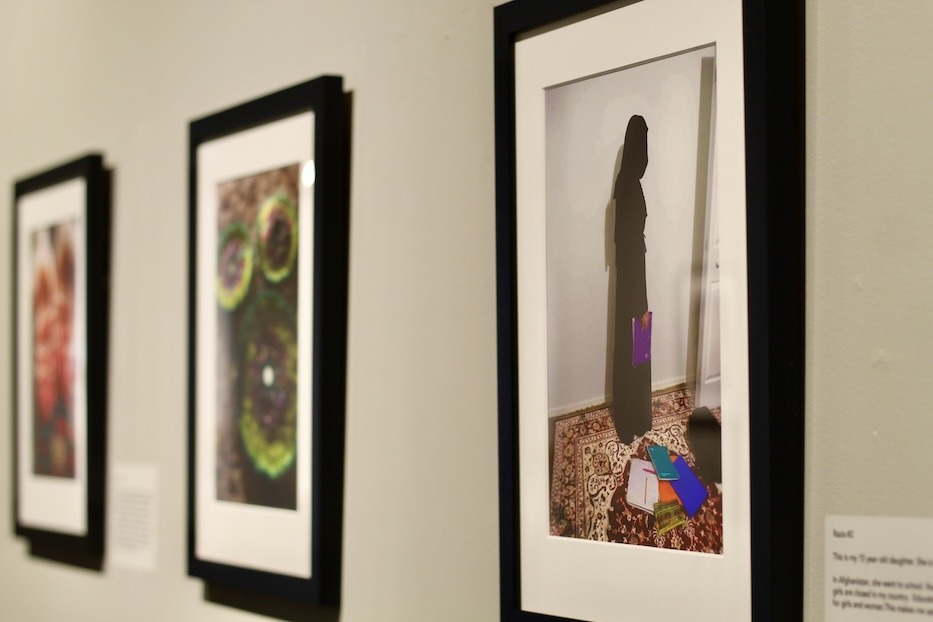
Taken individually and together, the works push a viewer (or at least, this viewer) to move beyond what they think they know of Afghan women, and open their hearts, minds and eyes to the possibility that they might learn something. It bucks white savior-y and dominant narratives, giving power back to a group that is often doubly disenfranchised—first by Afghanistan, and second by a new home that treats both refugees and women as second-class citizens.
“This was such an amazing way for them to share their stories,” Golden said. She praised Wilson Branch Manager Meghan Currey, Kehler Liddell (KLG), and artists Rod and Penhryn Cooke, who helped print, mat, frame, and install the images at almost no cost to CRIW. “It was so important to honor what they said their aspirations are.”
It is just one aspect of the work that CRIW does, Golden added. In the corner of the exhibition, viewers can access a document showing “Story Cloths,” a one-day healing arts project that a second group of Afghan women completed with artist Hangama Amiri.
In the finished works (view them here), women have depicted everything from traditional dress and the Afghan flag to sweeping landscapes, where trees and mountains rise up past a silhouette of an artist’s father.
For Samadi, both projects shine a light on Afghanistan at a time when the country—particularly its women—is still in crisis, but the Western news cycle has completely moved on.
“Afghan women are still suffering,” she said. “It’s not the hot topic for news anymore, but it is not changing for the best. It’s changing for the worst.”
Kehler Liddell Gallery is located at 873 Whalley Ave. in New Haven’s Westville neighborhood. It is open from noon to 5 p.m. Thursday through Sunday or by appointment. A tour and gallery talk of the show is scheduled for 3 p.m. on Friday, June 21 as part of the International Festival of Arts & Ideas. Register here.
This post was originally published on this site be sure to check out more of their content

